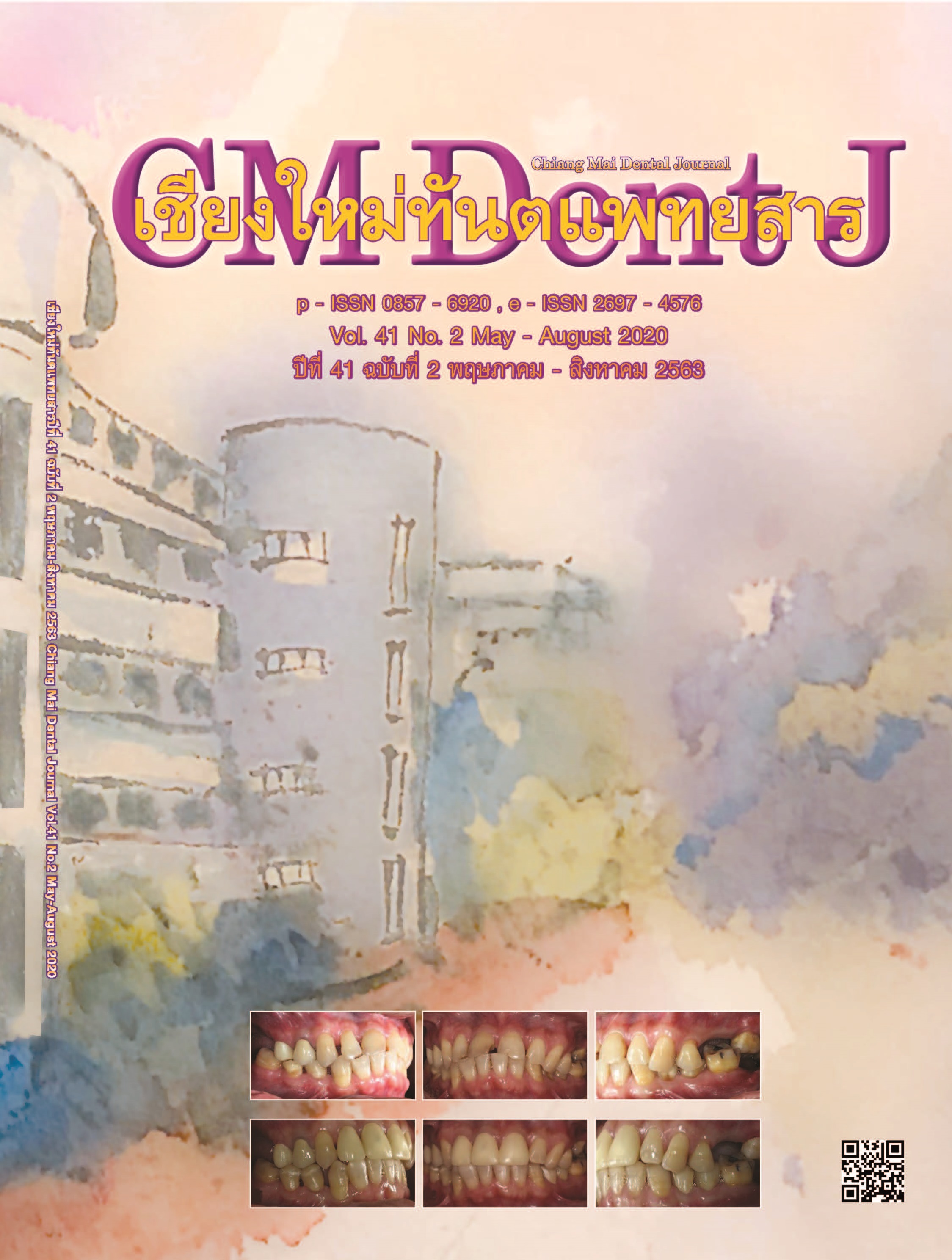The Study of Surface Roughness and Flowability of Distilled Water on a Zirconia Plate After Treated with Various Types of Coupling Agent Solution
Main Article Content
Abstract
Objective: The aim of this study is to examine the occlusal parameters in the general population in different age groups, which there is still a few studies.
Materials and Methods: Fifty-six Thai subjects were divided into three different groups of age; group 1; young adulthood 20-39 years (10 males, 15 females), group 2; middle adulthood 40-60 years (10 males, 15 females) and group 3; elder more than 60 years (2 males, 4 females). The T-Scan III computerized occlusal analysis system was used to record a multi-bite closure and the occlusal parameters for each subject in all age groups. The percentage of occlusal force distribution, the occlusal contact area, the occlusion time and the disclusion time were calculated for all groups. Paired-sample t-test or Wilcoxon match-pair signed-rank test (p<0.05) was used to compare the within group differences, while a One-way ANOVA or Kruskal-Wallis H test (p<0.05) was used to analyze the differences between the three groups.
Results: The occlusal force distribution, the occlusal contact areas, the occlusion time and the disclusion time during maximum intercuspation position were similar in all groups. There was no statistically significant difference (p>0.05) in all groups. When the occlusal force distribution was compared within group, the bilateral right to left side occlusal force distribution was not statistically different for all groups. Statistically significant differences (p = 0.001) of occlusal distribution were recorded between the anterior and posterior quadrants in all groups which the more values were found in posterior when compared to the anterior areas. Moreover, a statistically significant difference (p=0.023, and p=0.021) was found in disclusion time during left and right lateral excursion, respectively.
Conclusion: This present study found no differences in the occlusal force distribution, occlusal contact areas, occlusion time and disclusion time between three different age groups. Only the differences of the disclusion time during left and right lateral excursion were found.
Article Details
References
Becker RM. Biometrics role in occlusion. Compend Contin Educ Dent 2009; 29: 1-6.
Dawson PE. Functional Occlusion. In: TMJ to Smile Design. 1st ed. St. Louis, MO: Mosby Elsevier; 2007: 223-230.
Turp JC, Greene CS, Strub JR. Dental occlusion: a critical reflection on past, present and future concepts. J Oral Rehabil 2008; 35(6): 446-453.
Baker PS, Parker MH, Ivanhoe JR, Gardner FM. Maxillomandibular relationship philosophies for prosthodontic treatment: a survey of dental educators. J Prosthet Dent 2005; 93(1): 86-90.
Koirala S. Force finishing in dental medicine: A simplified approach to occlusal harmony. In: Kerstein RB, ed: Computerized occlusal analysis technology applications in dental medicine volume II. Pennsylvania: IGI Global; 2015: 905-913.
Qadeer S, Yang L, Sarinnaphakorn L, Kerstein RB. Comparison of closure occlusal force parameters in post-orthodontic and non-orthodontic subjects using T-Scan III DMD occlusal analysis. J Craniomandib Pract 2016; 34(6): 395-401.
Sadamori S, Kotani H, Abekura H, Hamadab T. Quantitative analysis of occlusal force balance in intercuspal position using the Dental Prescale system in patients with temporomandibular disorders. Int Chin J Dent 2007; 7: 43-47.
Wieczorek A, Loster J, Loster BW. Relationship between occlusal force distribution and the activity of masseter and anterior temporalis muscles in asymptomatic young adults. Biomed Res Int 2013; 23: 1-7.
Gümüş HÖ, Kılınç Hİ, Tuna SH, Özcan N. Computerized analysis of occlusal contacts in bruxism patients treated with occlusal splint therapy. J Adv Prosthodont 2013; 5(3): 256-261.
Lee SM, Lee JW. Computerized occlusal analysis: correlation with occlusal indexes to assess the outcome of orthodontic treatment or the severity of malocclusion. Korean J Orthod 2016; 46(1): 27-35.
Imamura Y, Sato Y, Kitagawa N, et al. Influence of occlusal loading force on occlusal contacts in natural dentition. J Prosthodont Res 2015; 59(2): 113-120.
Kerstein RB, Wright N. Electromyographic and computer analyses of patients suffering from chronic myofascial pain-dysfunction syndrome: before and after treatment with immediate complete anterior guidance development. J Prosthet Dent 1991; 66(5): 677-686.
Kerstein RB, Farrel S. Treatment of myofascial pain dysfunction syndrome with occlusal equilibration. J Prosthet Dent 1990; 63(6): 695-700.
Kerstein RB. Disclusion time measurement studies: a comparison of disclusion time between chronic myofascial pain dysfunction patients and nonpatients: a population analysis. J Prosthet Dent 1994; 72(5): 473-480.
Afrashtehfar KI, Qadeer S. Computerized occlusal analysis as an alternative occlusal indicator. J Craniomandib Pract 2016; 34(1): 52-57.
Kerstein RB. History of the T-Scan System Development from 1984 to the present day. In: Kerstein RB, ed: Computerized occlusal analysis technology applications in dental medicine volume I Pennsylvania: IGI Global; 2015. 1-30.
Asawaworarit N, Mitrirattanakul S. Occlusal scheme in a group of Thais. J Adv Prosthodont 2011; 3(3): 132-135.
Beyron H. Occlusal relations and mastication in Australian aborigines. Acta Odontol Scand 1964; 22: 597-678.
Zivko-Babić J, Pandurić J, Jerolimov V, Mioc M, Pizeta L, Jakovac M. Bite force in subjects with complete dentition. Coll Antropol 2002; 26(1): 293-302.
Okeson JP. Criteria for optimum functional occlusion. In: Management of temporomandibulars and occlusion. 7th ed. China: Elsevier Mosby; 2013. 73-85.
Takaki P, Vieira M, Bommarito S. Maximum bite force analysis in different age groups. Int Arch Otorhinolaryngol 2014; 18(3): 272–276.
Chong MX, Khoo CD, Goh KH, Rahman F, Shoji Y. Effect of age on bite force. J Oral Sci 2016; 58(3): 361-363.
Ikebe K, Nokubi T, Morii K, Kashiwagi J, Furuya M. Association of bite force with ageing and occlusal support in older adults. J Dent 2005; 33(2): 131–137.
Shinogaya T, Bakke M, Thomsen CE, Vilmann A, Sodeyama A, Matsumoto M. Effects of ethnicity, gender and age on clenching force and load distribution. Clin Oral Investig 2001; 5(1): 63-68.
Kumagai H, Suzuki T, Hamada T, Sondang P, Fujitani M, Nikawa H. Occlusal force distribution on the dental arch during various levels of clenching. J Oral Rehabil 1999; 26(12): 932-935.


